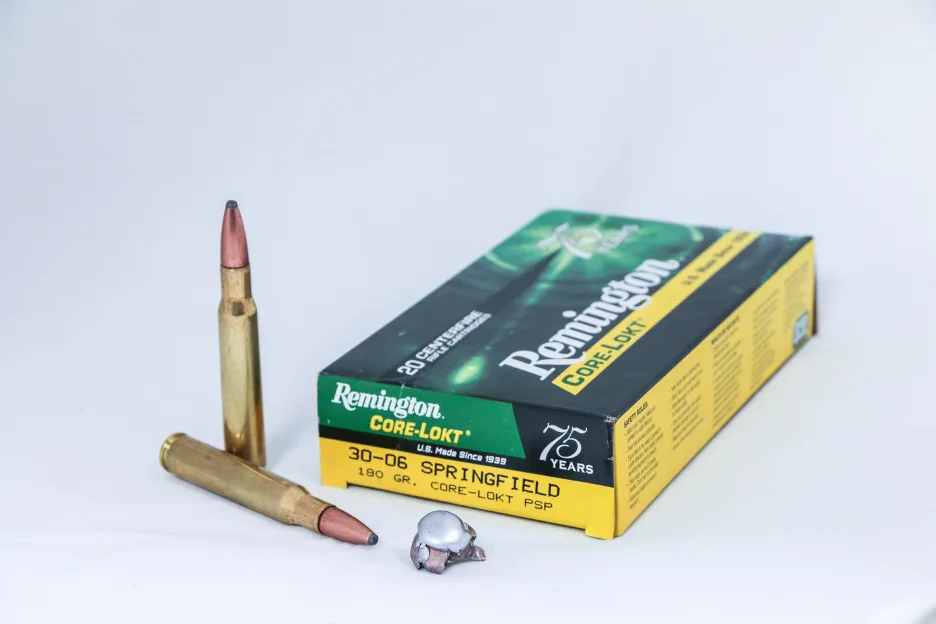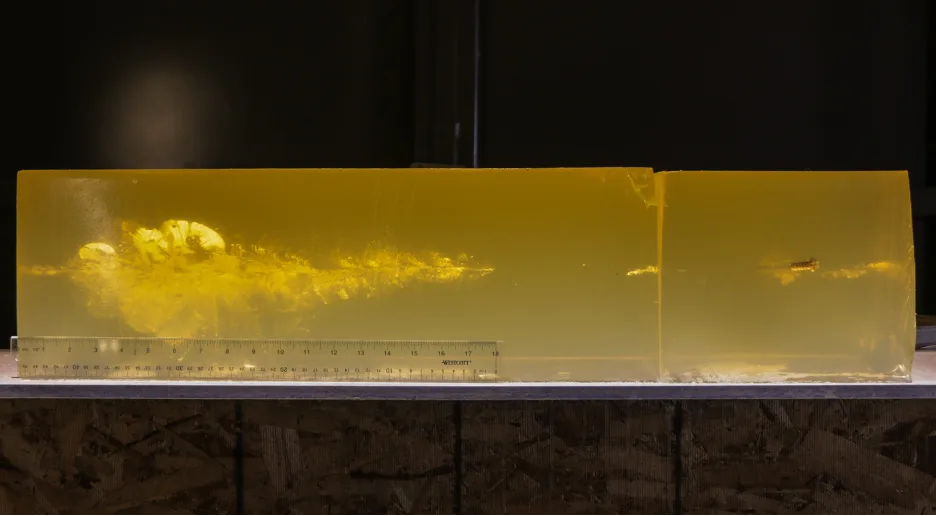We may earn revenue from the products available on this page and participate in affiliate programs. Learn more ›
_
When it comes to cartridge comparisons, the 308 vs 30/06 is one worth investigating. It is also a comparison deeply influenced by emotion. Many hunters grew up with grandfathers and fathers who trusted the 30/06. It was the cartridge that helped many come home from war; it saved their lives. The 30/06 has been praised to the point it is now an icon, and those who question its greatness are considered heretics. At the same time, the 308 Winchester has a solid connection to post-Korean-War veterans and a well-established reputation in precision rifles. So, the key to sorting out the 308 vs 30/06 debate should be to separate the assessment from all emotion and focus on nothing but fact.
308 vs 30/06 Table of Contents
The 30/06 Springfield
The 308 Winchester
308 vs 30/06: External Ballistics
308 vs 30/06: Terminal Ballistics
And the Winner is…
The 30/06 Springfield

| The 180-grain Remington Core-Lokt load is a classic 30/06 load for big game hunting. Richard Mann |
This cartridge got its name because it fires a 30-caliber (308-inch diameter) bullet and was introduced in the year of 1906. The cartridge and the Springfield rifle were issued to American servicemen, and together they won WWI. Before WWII, the Springfield bolt-action rifle was replaced with the M1 Garand, and that rifle and the 30/06 helped our troops win yet another World War. The original 30/06 ballistics allowed for a 150-grain bullet to be pushed to 2700 fps. In the first decade of the 20th century, this qualified as an extreme-high-performance cartridge.
How far can a 30/06 shoot? Well, with those ballistics, it can push a bullet beyond two miles.
The ballistics of factory 30/06 ammunition is much better today. One of the flattest shooting modern 30/06 loads is the Precision Hunter load from Hornady. It will push a 178-grain bullet to about 2750 fps. If sighted in at 200 yards, the bullet will only fall 44.3 inches below the line of sight at 500 yards. And it will still deliver 1533 foot-pounds of energy at that distance. After WWII, similar ballistics made the 30/06 very popular for hunting and when new bolt-action sporting rifles were introduced, they were almost always chambered for the 30/06 Springfield first.
The 308 Winchester

| This 165-grain AccuBond bullet was fired from a 308 Winchester and was recovered from a bull moose. Like the 30/06, the 308 Winchester is sufficient for all non-dangerous game. Richard Mann |
Looking for a shorter cartridge with similar ballistics to the 30/06, the U.S. Military developed the 308 Winchester in the early 1950s. With the advancements in modern propellants of that time, the 308 or 7.62x51mm NATO, as it is often called, allowed for near 30/06 performance out of individual and crew-served weapons that were shorter and lighter. The 308 and the M14 replaced the 30/06 and the M1 Garand as America’s military service rifle. Since then, the cartridge has served our troops in various machine guns, the SR25 semi-automatic rifle, as well as in various bolt-action sniper-type rifles. The 308 Winchester also became very popular for big game hunting.
The primary physical difference between the 30/06 and 308 is the size of the cartridge case. The 30/06 case is 2.494 inches long and the 308 case is 2.015 inches long. Like with the 30/06, one of the best ballistically performing factory loads for the 308 Winchester is the Hornady Precision Hunter. It will launch a 178-grain bullet to about 2600 fps. With a 200-yard zero, this bullet will fall 50.2 inches below the line of sight at 500 yards, while retaining 1346 foot-pounds of energy. Even though the 30/06 case is about 24% longer than the 308 case, from an external ballistics standpoint it only offers about a 6% increase in velocity. This is in line with the rule that velocity increases at a rate of one to four in relation to case capacity.
308 vs 30/06: External Ballistics
When comparing the 308 to 30/06 performance, the best tool we have is external ballistics. Given bullets of the same weight, such as in the Hornady Precision Hunter load, the 30/06 will hit about 14% harder and shoot about 14% flatter. However, this advantage in energy on target and a flatter trajectory is offset by more recoil. Out of an eight-pound rifle, the 30/06 will, on average, will recoil about 14% harder than the 308. This may or may not matter to the shooter, but around 20-foot pounds of recoil, which is common for the 308 Winchester, has been found to be about the upper level of comfort for many shooters during sustained fire.
Some will argue that in the 30/06 vs 308 discussion, the fact that the 30/06 will work better with heavier bullets, like those weighing 220 grains, must be considered. Back in the day of poorly constructed bullets, that did give the 30/06 an advantage because the slower 220-grain bullets would hold together better and penetrate deeper. Now, however, with bonded and mono-metal bullets, the heavier 220-grain 30/06 bullet will perform no better than a 168-grain bullet from a 308 Winchester or 30/06. In fact, at 300 yards a 168-grain Barnes TSX bullet fired from a 308 Winchester will perform as much as 15% better in terms of velocity, energy, and trajectory, than will most 220-grain bullets fired from a 30/06.
308 vs 30/06: Terminal Ballistics
When comparing the 30/06 vs 308 for hunting, we must also look at terminal ballistics. Keep in mind that both cartridges utilize the same diameter, weight, and style of bullets. So, the only difference between the two—from a terminal performance standpoint—is the slightly faster velocities the 30/06 offers. However, if you think there’s an animal or a forensic pathologist who can tell the difference between a wound created by a 30/06 and one created by a 308—when the same bullet is used—you’re a fool.
Yes, given the same bullet, the 30/06 will shoot harder and the bullet will fly flatter than if it were fired from a 308. However, the difference is so minuscule that, inside 250 yards or so, it is indistinguishable from a terminal performance perspective. On the other hand, if you’re shooting at extreme distances, you can reach a distance where the 30/06 does have an advantage. This is best illustrated when it comes to the minimum velocity needed to initiate bullet expansion. A modern mono-metal bullet like the Barnes TSX needs to impact at about 2000 fps to deliver optimum expansion/deformation. If we compare a 168-grain TSX from a 308 and a 30/06, the bullet fired from the 30/06 will deliver reliable bullet upset out to about 400 yards. The 308 Winchester however will run out of the velocity needed for reliable bullet upset at around 350 yards.

| Modern mono-metal bullets like the Barnes Triple Shock, when fired from a 308 or a 30/06, will deliver better external ballistics and terminal performance than 220-grain 30/06 loads. Richard Mann |
Read Next: The 12 Best Cartridges for Elk Hunting
And The Winner Is
When it comes to the 308 vs 30/06, and ballistic performance is what is being compared, the main difference is that the 30/06 offers about 50 yards or so more reach. But that 50-yard advantage in reach, which—depending on the bullet used—only begins to become relevant at around 350 yards, you’ll have to suffer through about 14% more recoil. Additionally, when comparing rifles of the same type, a 30/06 rifle will weigh about five to eight ounces heavier due to its longer action.
Another consideration in the 308 vs 30/06 debate is ammunition. Though it has not always been the case, there is now a wider selection of factory 308 ammunition available than there is for the 30/06. A major online retailer lists 172 different 308 Winchester loads and only 116 different 30/06 Springfield loads. Granted, many of the 308 Winchester loads are for plinking or precision shooting, but the availability of a wider selection of ammunition for the 308 Winchester is significant. So too is the fact that the 308 Winchester will work in AR10s, which are becoming more and more popular for big game hunting.
All things considered, when it comes to the 308 vs 30/06 for hunting, the 30/06 has a slight ballistic advantage that’s offset by slightly more recoil and a slightly heavier rifle. Both cartridges are suitable for all the non-dangerous game animals all over the world, and no metric exists that can differentiate between which one will kill better than the other. Of all the cartridge comparisons we might make, with the 308 vs the 30/06, the facts are so similar that emotion might actually be the most important consideration. You need to like the cartridge you hunt with and for most hunting situations there’s just not enough ballistic difference between these two to really matter. Pick the one that makes your heart beat the fastest, comes in the rifle you like the best, and don’t sweat the little stuff.
Frequently Asked Questions
Is the 30/06 more powerful than a 308?
Both the 30/06 and 308 are ballistically so similar that inside 250 yards, it’s hard to tell the difference between them. However, out at distances of 350 to 400 yards things change. The bump in velocity from the 30/06 helps bullets expand more reliably at 400 yards. Generally, the 308 can only have reliable expansion inside 350 yards.
Does a 30/06 Kick Hard?
It depends on your tolerance for recoil. Generally, it’s around the upper end that most people consider comfortable. When shot from an 8-pound rifle, the 30/06 will kick 14% harder than a 308. Depending on the weight of the rifle and the way the stock fits, you will experience more or less recoil from a 30/06—or any rifle cartridge.






